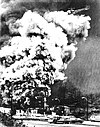 Mine entrance, now blocked | |
| Date | January 27, 1891 |
|---|---|
| Time | 9:00 AM |
| Location | Westmoreland County, Pennsylvania |
| Coordinates | 40°12′02″N79°28′02″W / 40.20054825670539°N 79.46722525752307°W |
| Cause | Gas explosion |
| Casualties | |
| 109 dead | |
The Mammoth Mine disaster or Frick Mine explosion occurred on January 27, 1891 just after 9:00 AM in the Mammoth No. 1 mine in Mount Pleasant Township, Westmoreland County, Pennsylvania. [1] Newspapers reported [2] that firedamp was ignited by a miner's oil lamp, resulting in the deaths of 109 men and boys. Most of the miners were not killed by the force of the explosion, but rather were suffocated by the effects of afterdamp.



